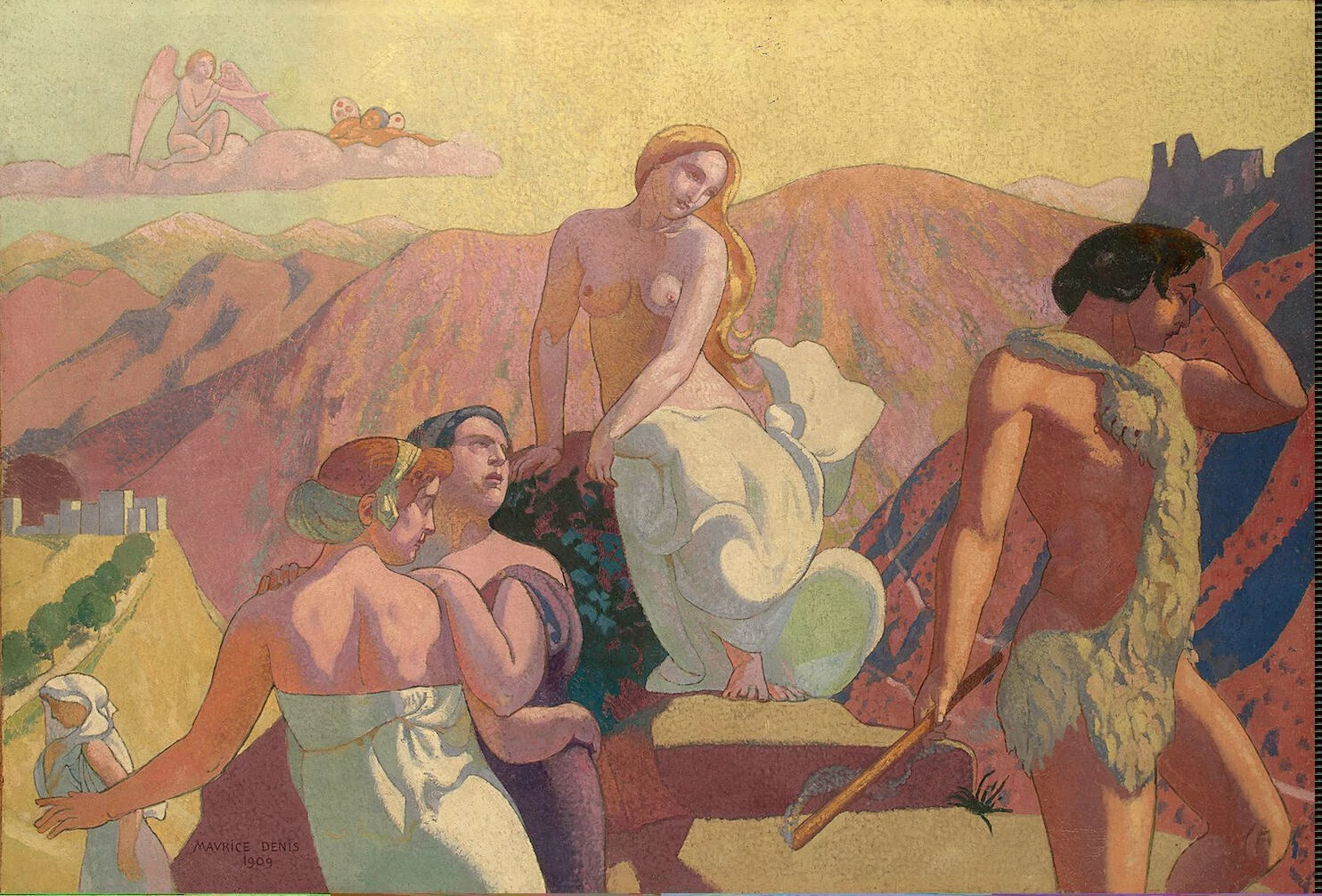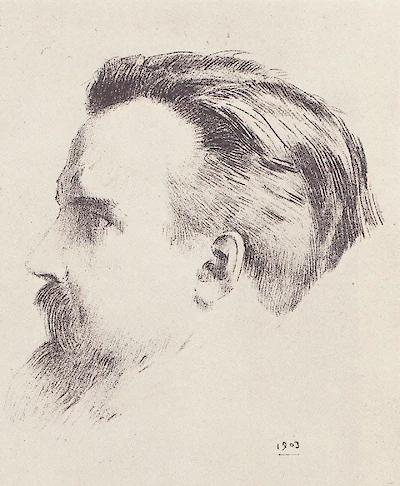

Maurice Denis
Art as prophesy
1870 – 1943Maurice Denis wrote the following passages in his private journal from ages 15 to 34. A fiercely devout young man, Denis wished to become a monk, following in the footsteps of his hero, Fra Angelico. His obsession with Fra Angelico motivated Denis in both art and chastity, but like many young men, Denis fights the temptation of the flesh. How to paint the human body and maintain purity of mind?
Earlier, I made an aquarelle from Fra Angelico’s revered head in the manner of Fra Bartolomeo. I have done a pretty good job of it. It is a treasure. I am gathering the required materials to write a practical summary of the life of this saint artist. Whatever may happen, I will do it. And later, I will go seek our Dear Father the Pope, to ask him that the dominican be solemnly beatified. And then—oh, how beautiful it would be—I would erect for him a magnificent chapel in the middle of Paris, that my confreres and I would strive to ornate with paintings, frescoes, painted retables, predella, bezels…Oh! how beautiful it would be. And every year, our religious and artistic society would come and hear the mass with a canvas of him under the arm. And after the mass would be over, the contributions—of an exclusively religious nature—would be hung ad hoc in a room. The display would end with a second mass in our church!… How I know well how to dream!
I ran to the Louvre. Finally, I am going to admire some artwork from my Angelico! It is the Coronation of The Virgin, a painted retable from San Domenico da Fiesole, to the left of the entrance, with six scenes of St. Dominic’s life on the predella. I shall not describe to you the large composition — not like the catalogue that Lemesle was kind enough to lend me. At first glance, what is most striking is the dazzling brightness that inundates all the characters: the lighting is diffused, the daylight is white. The relief is local, and the halftones are wonderfully shaded; the shadows are non-existent. This celestial light adds a lot to the mysticism of the scene: it really moved me. I hardly knew whether to leave or to stay before such a divine image. He did not just paint a portrait, he painted souls, he drew out of matter the very essence of religion.
The colors are pale, like shadows; there are no tints, the colors are pure: reds, blues, no purple. I think that Fra Angelico used a hatching process, at least in certain parts.
It is truly a painted prayer. Vasari says it is his master piece. Maybe it is.
Not to be a curmudgeon, let me say right away that Veuillot’s letter to an artist from the monastery really moved me. The portrait he paints of the artist is supremely accurate: “The painter is he who has his pencils, his brushes and his Journée du Chrétien; he who loves this saint whom he is painting; who loves him and is loved by him, and can still taste the ineffable joy of love: that is to work for the glory of him whom he loves.” That is so beautiful! I shall indeed work for the glory of whom I love when I paint Fra Angelico’s glorification. This artwork that will certainly shine at my first Salon. This artwork will be my hope, my dream, my goal. It will make me famous by the powerful agency of the Beato! Oh please, understand me. Veuillot has a conception supremely correct when he depicts God, the formidable Father of vocations, as saying in a majestic passion to this coward who deserted his Art career to earn a lot of money—coward! “Do not find an excuse for the temptations that the happiness (?) of men’s money brought you. I had made you a happier man than that!” A thousand times happier, as a matter of fact. Happy and proud to have been called by Him to such blissfulness in this life and in the other.
Balla again. I have strong hopes, despite everything. But I am a little bit afraid for my virtue. I think about this pitfall. I want to appear monacal, not in the least flirting with my models. I must keep Jeanne in my heart, and my focus on Fra Angelico. I want people to say of me later that the man who painted these pure things had a pure life.
Painting is mainly a religious and Christian art. If that character faded during the impious century we live in, we must find it again. And the means for doing that, is to make it a point of honor to reestablish the aesthetic of Fra Angelico, the only one truly catholic; the only one that truly answers the aspirations of the devout, mystic souls who love God. The world will embrace this response. The medievalists are increasing. The primitives are being fought over, even the strangest and most mediocre ones.
This morning, my mother came very close to taking a page from my notes. One o’clock. My mother knows everything. Everything! My mother is crying; she does not want me to become a monk. She is shaking like a leaf… I had written all my story and I had decided to give this paper to Mr. Vautier. But, will I do it? Why should I let people think I am crazy?
The priest read it. He gave me advice. This young lady, you are very young to love her. If this love is but admiration, then there is nothing to worry about. Do not rush into things. Finish your schooling, and then, if you want, become a painter. Your ideal to paint Fra Angelico is not unrealistic. As for your piety, take my advice, let’s not exaggerate madly. Come and see me often. He had a lot of difficulty admitting the godly effect Jeanne had on me…
Here I am finally, calm, comforted, delivered from my heavy secret and from my uncertainties… But, must I give up these beautiful dreams, break with all these noble sentiments, leave these invigorating hopes? I do not deny what I have thought about; I do not abandon what I have hoped for. But I do not want to daydream… So many things this year!…
Beato Fra Angelico’s anniversary. Oh! Brother, when I think of you and of my dreams of yesteryear, turning my eyes away from profane beauty, my ears from impure singing, oh! Brother, how I have changed! I have no more on Art or on Goodness the same ideas as I did at the time of Jeanne the Gentle; or rather, to those ideas, an infinity of others have been added. I still love you and your mystical painting and your virginity, and your divine beauties, oh! Brother; but now I love too dear mother Nature and the beauty of the body.
I used to say: “What is naked is chaste, what is naked is beautiful,” and I didn’t know what it was. Now, I know it and I like it; alas! why must it not be chaste? and why must attractive delights of necessity be indecent? It is these girls who, to my ideal of the white robed Virgin, added this other ideal of the naked Virgin. Instead of the cloister, I found the Studio, the Studio with its frivolity, its debauchery; and I, I am searching to unite my learnings of the earth to my learnings of the heaven, and my reason, enlarged, opens up to more diverse thoughts.
Oh! Brother, have I done wrong? May it be that always, the Spirit that gives Life to the Spirit present in your saint artwork dominate over the form that intoxicates, over the color that fascinates, oh! Angelic Brother. You used to say: “To paint the things of Christ, one must live with Christ.” ’Tis an easy task among the just, but not here. However much I try, my life will be subject to the influence of my environment; and my painting subject to the influence of my life. Whatever is candid in me, and simple, will have to depart, whether I want it or not. Nevertheless, Brother, I would like to become better, become pure and saint. All in all, this is the only thing needed. For I know how our most precious revery fades away, and how there are days when one desires most intensely the Eternal Life.
I heard the sacred word: be within. I have no hope for rest in this world. If the grace of God does not subtract me from it, woe is me. Who is my work for? This work of my dreams, those days of longing, that so leave me distressed and scorned lately. May Fra Angelico preserve me from the smiles of this world. And what if the saints do not understand me? It is just as well I do not possess sentiments of modern devotion. I have loved the old ages. From what majesty will come the power that will renew the Church’s Art and that will witness the sanctification of the Lord’s mercy this century!
Celebrated the anniversary of Fra Angelico: mass, redemption, the first violets. My God, such happiness, such pure happiness you bring me. Never mind the worse worries, if I know that faced with skepticism, I am faithful; faced with their mistrust, I surrender to the persuasions of my heart.
Despite the annyoing difficulties of the last few weeks, Maurice and Martha remember Angelico’s anniversary and turn to him for his protection. Had success at the Salon of the Independents and received good wishes from elsewhere. Reread the prior memoirs of this anniversary: oh! how our art and our affections are governed by this spirit that gives life.
This evening, I rode my bicycle back to Tivoli. In the calm of the night, I heard the song of a shepherd’s bagpipe. The countrysight took on a depth of blue shadows, valleys imperceptible during the day. I saw the olive woods of Tivoli. Meditated near Fra Angelico’s grave. Instead of laboring lovingly on the object of our art, we think deeply on what there is to learn about the labor or about the art. But to know and to do are two distinct things. How science is becoming our divinity. Learning is not everything in life: as much as possible, the artist should put a limit on this need to learn. How? by learning, not from one’s single experience, but from the craft taught or tradition, from the experience of all those who have preceded us.
— MAURICE DENIS